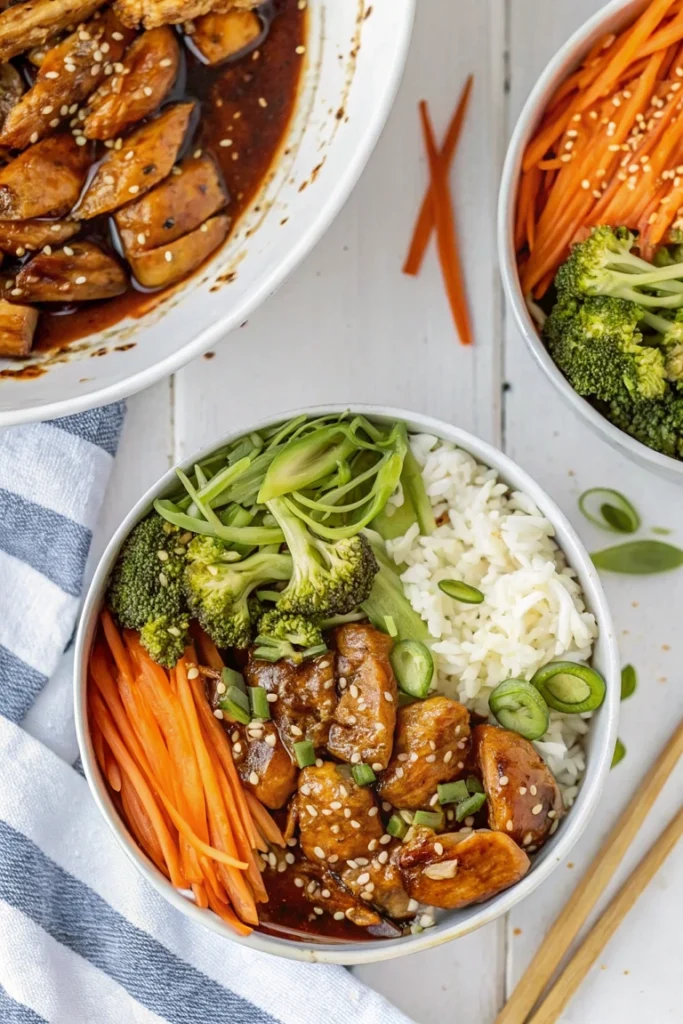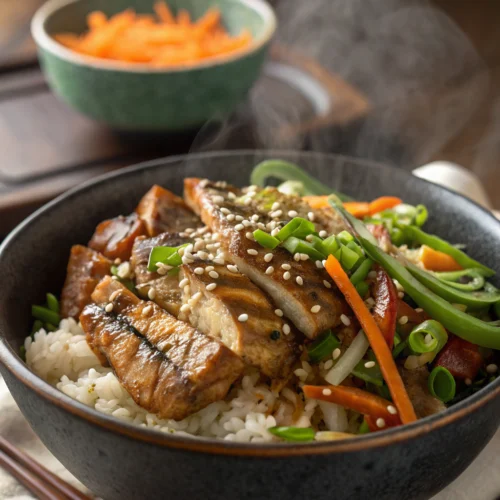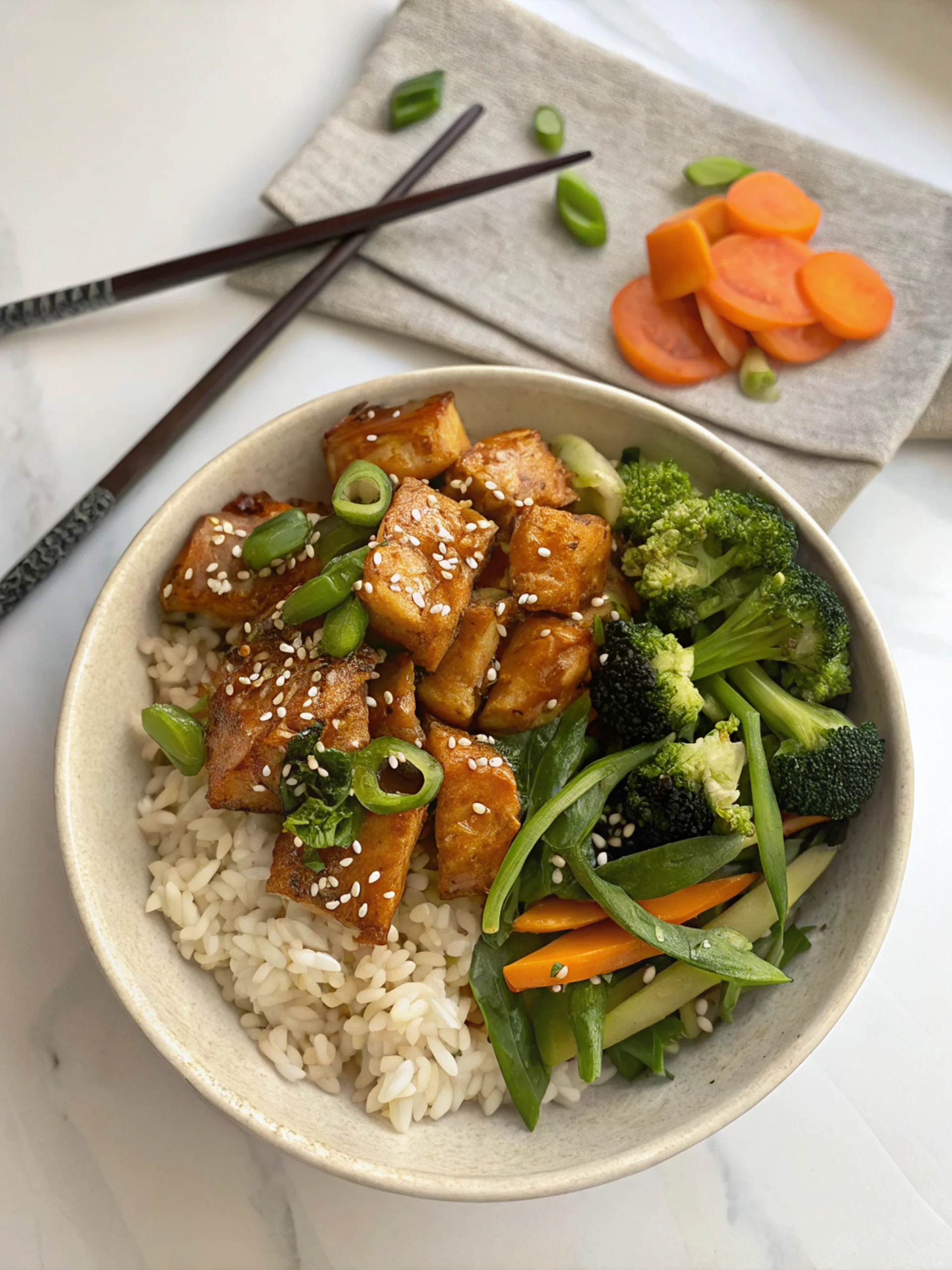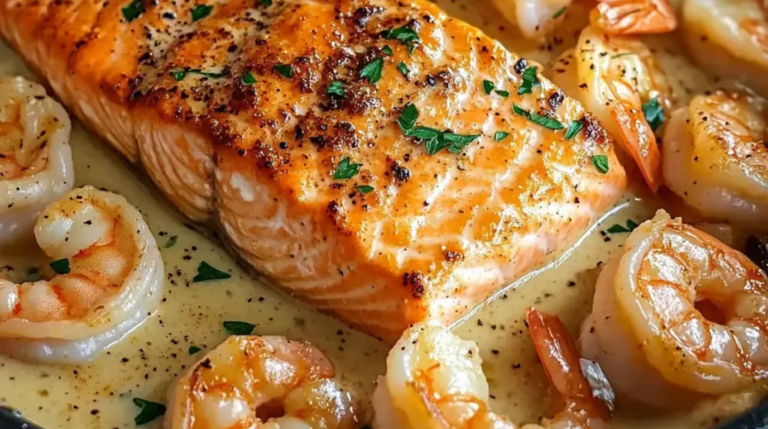Table of Contents
The Magic of Teriyaki Bowls: Why I’m Obsessed (And You Will Be Too!)
There’s something almost magical about a perfectly assembled teriyaki bowl. The sticky-sweet glaze coating tender protein, the colorful vegetables, and that bed of fluffy rice soaking up all those incredible flavors… it’s comfort food with a sophisticated edge.
I still remember my first encounter with a proper teriyaki bowl at a tiny Japanese restaurant tucked away in Seattle. One bite, and I was hooked! The balance of sweet, savory, and umami flavors was unlike anything I’d experienced before. Since then, I’ve spent years perfecting my own teriyaki bowl recipes, and today I’m sharing everything I’ve learned with you.
What makes teriyaki bowls so special isn’t just their incredible flavor—it’s their versatility and simplicity. Whether you’re cooking for picky eaters, health-conscious family members, or just yourself after a long day, a teriyaki bowl can be customized to please absolutely everyone.
What Exactly Is a Teriyaki Bowl?
A teriyaki bowl is a complete meal built around the Japanese cooking technique of teriyaki—where ingredients are grilled or broiled with a sweet-savory sauce made from soy sauce, mirin, and sugar. While traditional Japanese teriyaki focuses on fish, the American version we know and love typically features:
- A base of rice (usually white, but brown rice or other grains work too)
- Protein coated in teriyaki sauce (most commonly chicken, but beef, salmon, or tofu are fantastic options)
- Colorful vegetables, either stir-fried or fresh
- Additional toppings like sesame seeds, green onions, or nori
The beauty of a teriyaki bowl is that once you understand the basic formula, you can mix and match ingredients based on what you have on hand or what you’re craving that day.

The Secret to Amazing Chicken Teriyaki Bowls
Let’s start with the crowd favorite: the chicken teriyaki bowl. This version has won over even my most skeptical dinner guests and has become my go-to when I need a guaranteed hit.
Ingredients You’ll Need
For the chicken:
- 1½ pounds boneless, skinless chicken thighs (or breasts if you prefer)
- 2 tablespoons vegetable oil
- Salt and pepper to taste
For the homemade teriyaki sauce:
- ½ cup soy sauce (low-sodium works great)
- ¼ cup water
- 3 tablespoons brown sugar
- 1 tablespoon honey
- 2 tablespoons mirin (Japanese sweet rice wine)
- 2 cloves garlic, minced
- 1 tablespoon fresh ginger, grated
- 1 tablespoon cornstarch mixed with 2 tablespoons water
For the bowl assembly:
- 3 cups cooked white rice
- 2 cups broccoli florets, steamed
- 1 carrot, julienned
- 1 cup edamame, shelled and cooked
- 2 green onions, thinly sliced
- 1 tablespoon sesame seeds
- Optional: sliced avocado, pickled ginger, nori strips
The Foolproof Method
Cook your rice first. I always start with rice because it can stay warm while you prepare everything else. For extra flavor, cook it in chicken broth instead of water!
Prepare the teriyaki sauce. In a small saucepan, combine soy sauce, water, brown sugar, honey, mirin, garlic, and ginger. Bring to a simmer over medium heat, stirring occasionally. Once the sugar dissolves, add the cornstarch slurry and continue to simmer until the sauce thickens to a glossy consistency that coats the back of a spoon, about 2-3 minutes. Remove from heat.
Cook the chicken. Cut chicken into bite-sized pieces and season with salt and pepper. Heat oil in a large skillet over medium-high heat until shimmering. Add chicken in a single layer (work in batches if needed—overcrowding is the enemy of good browning!). Cook for 3-4 minutes per side until golden brown and cooked through.
Marry the chicken and sauce. Pour about ⅔ of your teriyaki sauce over the cooked chicken, tossing to coat every piece thoroughly. Reserve the remaining sauce for drizzling.
Steam or stir-fry your vegetables. I like to steam broccoli until it’s bright green and still has some bite, about 3-4 minutes. For carrots and other vegetables, a quick 2-minute stir-fry keeps them colorful and crisp.
Assemble your masterpiece! Start with a base of warm rice, arrange your sauced chicken and vegetables on top, and finish with a drizzle of the reserved teriyaki sauce. Sprinkle with green onions and sesame seeds.
The Ultimate Homemade Teriyaki Sauce
While store-bought teriyaki sauce will work in a pinch, nothing compares to homemade. After testing countless variations, I’ve found the perfect balance that captures that authentic restaurant quality we all crave.
Why Homemade Sauce Makes All the Difference
The bottled stuff often contains preservatives and excessive sugar that can overpower the other ingredients in your teriyaki bowl. Making your own allows you to control the sweetness, adjust the thickness, and add fresh aromatics like ginger and garlic that make the flavor pop.
Make-Ahead Tip
This sauce keeps beautifully in the refrigerator for up to two weeks, so I often make a double batch. Store it in a glass jar, and you’ll have the foundation for quick teriyaki bowls anytime the craving strikes!
Beyond Chicken: Exciting Teriyaki Bowl Variations
While chicken teriyaki bowls might be the classic, limiting yourself to just one protein would be like only eating one flavor of ice cream your whole life—a tragedy! Here are some of my favorite teriyaki bowl variations that keep my family excited about dinner night after night.
Beef Teriyaki Bowl
For a richer, more indulgent teriyaki bowl, thinly sliced beef is the way to go. I recommend:
- Flank steak or sirloin, sliced against the grain
- A slightly shorter cooking time (about 2 minutes per side for medium-rare)
- Adding a bit more ginger to the sauce to complement the beef
- Pairing with heartier vegetables like mushrooms and bell peppers
Salmon Teriyaki Bowl
Salmon brings a beautiful richness and omega-3 boost to your teriyaki bowl:
- Use skin-on salmon fillets for the best flavor
- Marinate the salmon in some of your teriyaki sauce for 20 minutes before cooking
- Cook skin-side down first until crispy, then flip and glaze with sauce
- Complement with cucumber, avocado, and a squeeze of lime
Vegetarian Teriyaki Bowl
Contrary to popular belief, meat-free teriyaki bowls can be just as satisfying:
- Extra-firm tofu, pressed and cubed, makes an excellent protein base
- Toss tofu cubes in cornstarch before pan-frying for a crispy exterior
- Double up on vegetables: shiitake mushrooms, snap peas, bell peppers, and baby corn
- Consider adding pineapple chunks for a sweet-tart contrast
Building the Perfect Teriyaki Bowl: Components and Assembly
Creating a teriyaki bowl is like composing a beautiful song—each element contributes to the harmony of the final dish. Let’s break down the components of a truly memorable teriyaki bowl.
Choosing Your Base
While traditional teriyaki bowls feature white rice, don’t be afraid to experiment:
- White rice: The classic choice that soaks up sauce beautifully
- Brown rice: A nuttier, more nutritious alternative
- Cauliflower rice: For a lower-carb option
- Quinoa: Adds protein and a pleasant texture
- Soba noodles: For a twist on the traditional bowl
Protein Perfection
The star of your teriyaki bowl deserves special attention:
- Cut proteins into similar-sized pieces for even cooking
- Don’t overcrowd your pan—cook in batches if necessary
- Allow meat to rest before slicing to keep juices intact
- For the best caramelization, pat proteins dry before cooking
Vegetable Selection and Preparation
Vegetables add color, nutrition, and textural contrast to your teriyaki bowl:
- Aim for at least 2-3 different vegetables with varying colors
- Consider different cooking methods: raw for crunch, steamed for tenderness, roasted for depth
- Quick-cooking options include bell peppers, snap peas, and zucchini
- Longer-cooking vegetables like broccoli and carrots may need a head start
Finishing Touches
These small additions make a big impact:
- Texture elements: Sesame seeds, chopped peanuts, crispy wonton strips
- Fresh hits: Cilantro, green onions, lime wedges
- Heat options: Sriracha, sliced jalapeños, shichimi togarashi (Japanese seven-spice)
- Creamy components: Sliced avocado, a drizzle of spicy mayo
Meal Prep Magic: Teriyaki Bowls for Busy Weeks
One of the reasons I love teriyaki bowls so much is their meal-prep potential. When I know I have a hectic week ahead, I spend an hour on Sunday preparing components for quick assembly throughout the week.
Components to Prep Ahead
- Rice: Cooked and portioned into containers (reheat with a sprinkle of water)
- Protein: Cooked chicken, beef, or tofu (store separately from sauce to prevent sogginess)
- Teriyaki sauce: Stored in a jar ready for reheating
- Vegetables: Washed, chopped, and either raw or partially cooked
- Toppings: Measured into small containers or bags
Assembly Strategy
For the freshest results, keep components separate until ready to eat. If taking to work, layer in this order from bottom to top: rice, vegetables, protein, sauce in a separate container, toppings in a separate bag.
Storage Tips
- Cooked components last 3-4 days in the refrigerator
- Teriyaki sauce keeps for up to 2 weeks
- For longer storage, freeze individual portions of cooked rice and protein
- Fresh toppings like green onions should be cut just before serving
Health-Conscious Teriyaki Bowl Adaptations
Traditional teriyaki bowls, while delicious, can sometimes be high in sodium and sugar. Here are my favorite modifications for a more nutritious but equally satisfying meal:
Lower-Sodium Options
- Use low-sodium soy sauce or tamari
- Dilute your sauce with a bit more water or unsalted broth
- Increase aromatics like ginger and garlic to maintain flavor depth
- Add acid with rice vinegar or citrus juice to brighten flavors without salt
Reduced-Sugar Variations
- Replace some or all of the sugar with monk fruit sweetener or erythritol
- Use pineapple juice as a natural sweetener with added flavor
- Incorporate grated apple for sweetness and thickening power
- Try coconut aminos for a naturally sweeter, less salty alternative to soy sauce
Boosting Nutritional Value
- Increase the vegetable-to-rice ratio
- Swap white rice for brown rice, quinoa, or cauliflower rice
- Add seaweed for minerals and umami
- Include fermented vegetables like kimchi for probiotic benefits
Troubleshooting Your Teriyaki Bowl
Even experienced cooks encounter challenges! Here are solutions to common teriyaki bowl issues:
Sauce Too Thin?
- Simmer longer to reduce further
- Add an additional teaspoon of cornstarch mixed with cold water
- Remember that sauce thickens as it cools
Sauce Too Thick?
- Whisk in additional water, a tablespoon at a time
- Add a splash of mirin or rice vinegar to thin while adding flavor
Protein Turning Out Tough?
- For chicken thighs, aim for 165°F internal temperature but not higher
- For chicken breasts, consider a quick brine (1 tablespoon salt dissolved in 2 cups water) for 30 minutes before cooking
- Let meat rest before slicing
- Slice against the grain, especially for beef
Rice Sticking Together?
- Rinse rice thoroughly before cooking
- Let cooked rice rest with the lid off for 5 minutes
- Fluff with a fork before serving
- For meal prep, a light drizzle of sesame oil prevents clumping
FAQ: Everything You Want to Know About Teriyaki Bowls
What exactly does “teriyaki” mean?
The word “teriyaki” comes from the Japanese terms “teri” (meaning shine) and “yaki” (meaning grilled or broiled). It refers to the cooking technique where foods are brushed with a sweet-savory glaze that gives them a shiny appearance.
Can I make teriyaki bowls without refined sugar?
Absolutely! Try using honey, maple syrup, or coconut sugar instead of brown sugar. For even more natural options, pureed dates or applesauce can add sweetness to your teriyaki sauce.
How do I make my teriyaki sauce taste more authentic?
For that restaurant-quality taste, don’t skip the mirin! This sweet Japanese rice wine adds depth that can’t be replicated. Also, using fresh ginger rather than powdered makes a tremendous difference in the brightness of your sauce.
Can teriyaki bowls be frozen?
Yes, but with some caveats. Freeze the components separately: rice, cooked protein, and sauce can all be frozen for up to 3 months. Vegetables are best added fresh after reheating. Thaw overnight in the refrigerator and reheat gently with a splash of water to prevent drying out.
Are teriyaki bowls gluten-free?
Traditional teriyaki sauce contains soy sauce, which has wheat. For a gluten-free version, substitute tamari or coconut aminos for the soy sauce, and double-check that your mirin is gluten-free (some brands contain wheat).
What’s the best way to reheat leftover teriyaki bowls?
For the best texture, reheat rice with a sprinkle of water in the microwave, covered, for 1-2 minutes. Heat protein separately with a bit of sauce. Alternatively, a quick stir-fry in a hot pan revitalizes all components beautifully.
Let’s Share Our Teriyaki Bowl Adventures!
I hope this guide has inspired you to create your own teriyaki bowl masterpieces at home! Remember, these recipes are starting points—the beauty of teriyaki bowls lies in making them your own.
Have you tried making teriyaki bowls before? Do you have a secret ingredient or technique that takes yours to the next level? Maybe you’ve created a unique variation that your family loves?
I’d be thrilled to hear about your teriyaki bowl adventures in the comments below! Share your modifications, post photos of your creations, or ask any questions that came up during your cooking process.
And if you enjoyed this recipe, please consider sharing it with friends or pinning it for later. Every home deserves to be filled with the irresistible aroma of homemade teriyaki!
Until next time, happy cooking!
Hungry for more? Check out our top rated recipes :
- How to Master Marry Me Chicken Pasta in 25 Minutes Flat!
- Marry Me Shrimp Pasta: How to Make the Best 20-Minute Dinner!
- How to Make Garlic Parmesan Chicken Pasta: A Step-by-Step Guide
- How to Make Irresistible Chocolate Covered Potato Chips at Home

Teriyaki Bowl
Ingredients
- For the Teriyaki Sauce:
- ½ cup soy sauce
- ¼ cup water
- 2 tbsp honey or brown sugar
- 1 tbsp rice vinegar
- 1 tsp grated ginger
- 2 cloves garlic minced
- 1 tbsp cornstarch + 1 tbsp water slurry
- For the Bowl:
- 1 lb chicken breast or thighs sliced
- 1 tbsp oil vegetable or sesame
- 2 cups cooked rice
- 1 cup steamed broccoli
- 1 carrot julienned
- ½ cup sliced bell peppers
- Sesame seeds & green onions for garnish
Instructions
- Make the Teriyaki Sauce:
- In a saucepan, combine soy sauce, water, honey, rice vinegar, ginger, and garlic. Bring to a simmer.
- Mix cornstarch with water, then stir into the sauce. Cook until thickened (~2 min). Set aside.
- Cook the Chicken:
- Heat oil in a skillet over medium-high heat. Add chicken and cook until browned (~5-7 min).
- Pour half the teriyaki sauce over the chicken and stir to coat.
- Assemble the Bowl:
- Divide rice among bowls. Top with chicken, steamed broccoli, carrots, and bell peppers.
- Drizzle with extra sauce and garnish with sesame seeds & green onions.
Notes
- Substitutions: Use tofu or shrimp instead of chicken for a different protein.
- Storage: Leftovers keep for 2-3 days in the fridge.
- Extra Flavor: Add a splash of mirin or lime juice to the sauce for depth.







